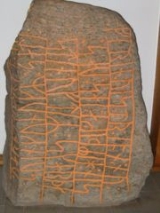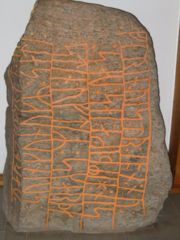
Hedeby stones
Encyclopedia

Hedeby
Hedeby |heath]]land, and býr = yard, thus "heath yard"), mentioned by Alfred the Great as aet Haethe , in German Haddeby and Haithabu, a modern spelling of the runic Heiðabý was an important trading settlement in the Danish-northern German borderland during the Viking Age...
in northern Germany
Germany
Germany , officially the Federal Republic of Germany , is a federal parliamentary republic in Europe. The country consists of 16 states while the capital and largest city is Berlin. Germany covers an area of 357,021 km2 and has a largely temperate seasonal climate...
. This area was part of Denmark
Denmark
Denmark is a Scandinavian country in Northern Europe. The countries of Denmark and Greenland, as well as the Faroe Islands, constitute the Kingdom of Denmark . It is the southernmost of the Nordic countries, southwest of Sweden and south of Norway, and bordered to the south by Germany. Denmark...
during the Viking Age
Viking Age
Viking Age is the term for the period in European history, especially Northern European and Scandinavian history, spanning the late 8th to 11th centuries. Scandinavian Vikings explored Europe by its oceans and rivers through trade and warfare. The Vikings also reached Iceland, Greenland,...
.
Stone of Eric
The Stone of Eric (cataloged as Hedeby 1 or DR 1 under the RundataRundata
The Scandinavian Runic-text Data Base is a project involving the creation and maintenance of a database of runic inscriptions. The project's goal is to comprehensively catalog runestones in a machine-readable way for future research...
system) was found in 1796 at Danevirke
Danevirke
The Danevirke The Danevirke The Danevirke (modern Danish spelling: Dannevirke; in Old Norse Danavirki ; in German Danewerk ; is a system of Danish fortifications in Schleswig-Holstein (Northern Germany). This important linear defensive earthwork was constructed across the neck of the Cimbrian...
and moved to a park in Schleswig
Schleswig
Schleswig or South Jutland is a region covering the area about 60 km north and 70 km south of the border between Germany and Denmark; the territory has been divided between the two countries since 1920, with Northern Schleswig in Denmark and Southern Schleswig in Germany...
. Like the Skarthi Stone, it is believed to have been raised around 995
995
Year 995 was a common year starting on Tuesday of the Julian calendar.- Europe :* Upon the death of Eric the Victorious, he is succeeded by his son Olof Skötkonung as the first baptized king of Sweden....
, during an attack from the Swedish king Eric the Victorious who took advantage of the fact that Sweyn Forkbeard was campaigning in England
England
England is a country that is part of the United Kingdom. It shares land borders with Scotland to the north and Wales to the west; the Irish Sea is to the north west, the Celtic Sea to the south west, with the North Sea to the east and the English Channel to the south separating it from continental...
.
Sigtrygg Runestones
The big Sigtrygg Stone (Hedeby 2 or DR 2) was found in 1797 in Hedeby, and the small Sigtrygg Stone (Hedeby 4 or DR 4) was found in 1887. The Sigtrygg Stones was raised around the year 938938
Year 938 was a common year starting on Monday of the Julian calendar.- Asia :* The Liao Dynasty takes over Peking; they name Nanjing as their South Palace....
.
Skarthi Stone
The Skarthi Stone , also known as Hedeby 3 or DR 3 for its RundataRundata
The Scandinavian Runic-text Data Base is a project involving the creation and maintenance of a database of runic inscriptions. The project's goal is to comprehensively catalog runestones in a machine-readable way for future research...
catalog number, was found in 1857 at Danevirke
Danevirke
The Danevirke The Danevirke The Danevirke (modern Danish spelling: Dannevirke; in Old Norse Danavirki ; in German Danewerk ; is a system of Danish fortifications in Schleswig-Holstein (Northern Germany). This important linear defensive earthwork was constructed across the neck of the Cimbrian...
. It was raised in about 982
982
Year 982 was a common year starting on Sunday of the Julian calendar.- Americas :* Greenland is discovered by Erik the Red .- Asia :...
. This granite runestone is currently displayed at the Hedeby Viking Museum
Hedeby Viking Museum
The Hedeby Viking Museum is a museum near the site of Hedeby, a former medieval city in Schleswig-Holstein, Germany focusing on the Viking Age history of the region. While the region is now in modern Germany, it was once the oldest city in Denmark until it was ceded in 1864...
.
The reference in the inscription to King Sveinn is believed to refer to Sweyn Forkbeard (Old Norse Sveinn Tjúguskegg), and "the west" to a campaign in England. The king commissioned the stone in honor of Skarði, who had the title heimþega or heimþegi (pl. heimþegar), meaning "home-receiver" (i.e., one who is given a house by another). A total of six runestones in Denmark refer to a person with this title, the others being DR 1
Stone of Eric
The Stone of Eric, listed as DR 1 in the Rundata catalog, is a memorial runestone that was found in northern Germany. This area was part of Denmark during the Viking Age.-Description:...
, DR 154, DR 155, DR 296, and DR 297. The use of the term in the inscriptions suggest a strong similarity between heimþegar and the Old Norse term húskarl (literally, "house man"), or housecarl
Housecarl
In medieval Scandinavia, housecarls and sometimes spelled huscarle or houscarl) were either non-servile manservants, or household troops in personal service of someone, equivalent to a bodyguard to Scandinavian lords and kings. This institution also existed in Anglo-Saxon England after its...
. Like housecarls, heimþegar are in the service of a king or lord, of whom they receive gifts (here, homes) for their service. Some, like Johannes Brøndsted
Johannes Brøndsted
Johannes Brøndsted, was a Danish archaeologist and prehistorian.-Biography:Brøndsted was born in Grundfør, Jutland....
, have interpreted heimþegi as being nothing more than a local Danish variant of húskarl.
Transliteration into Latin characters
- A : suin : kunukR : sati : ¶ stin : uftiR : skarþa ¶ sin : himþiga : ias : uas : ¶ : farin : uestr : ion : nu :
- B : uarþ : tauþr : at : hiþa:bu
Transcription into Old Norse
- A Sveinn konungr setti stein eptir Skarða, sinn heimþega, er var farinn vestr, en nú
- B varð dauðr at Heiðabý.
Translation in English
- A King Sveinn placed the stone in memory of Skarði, his retainer, who travelled to the west, but who then
- B died at Hedeby.

